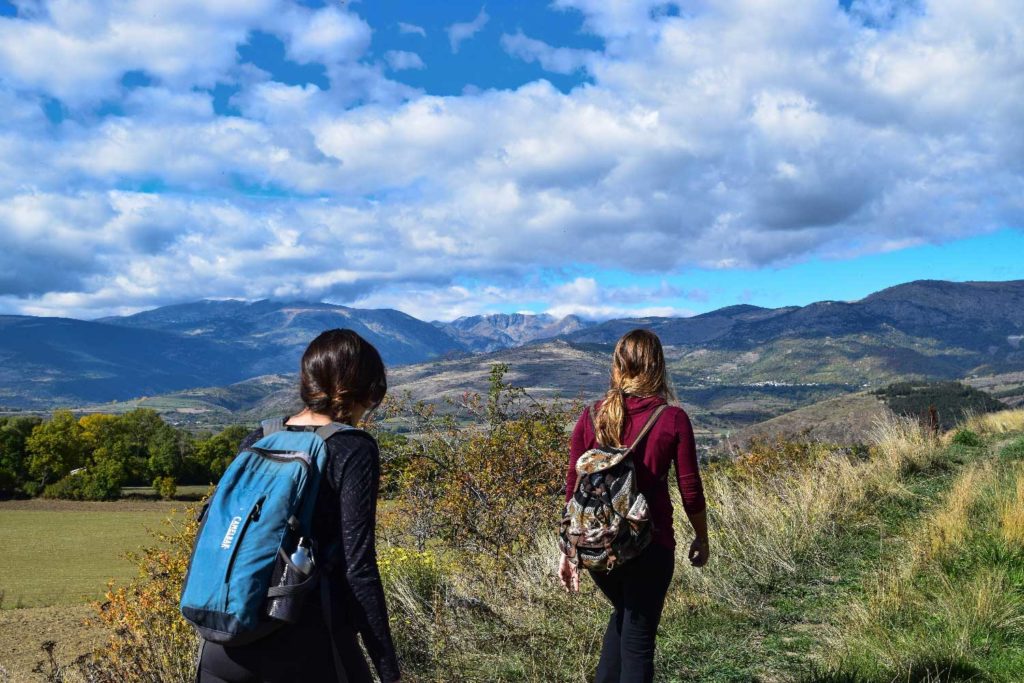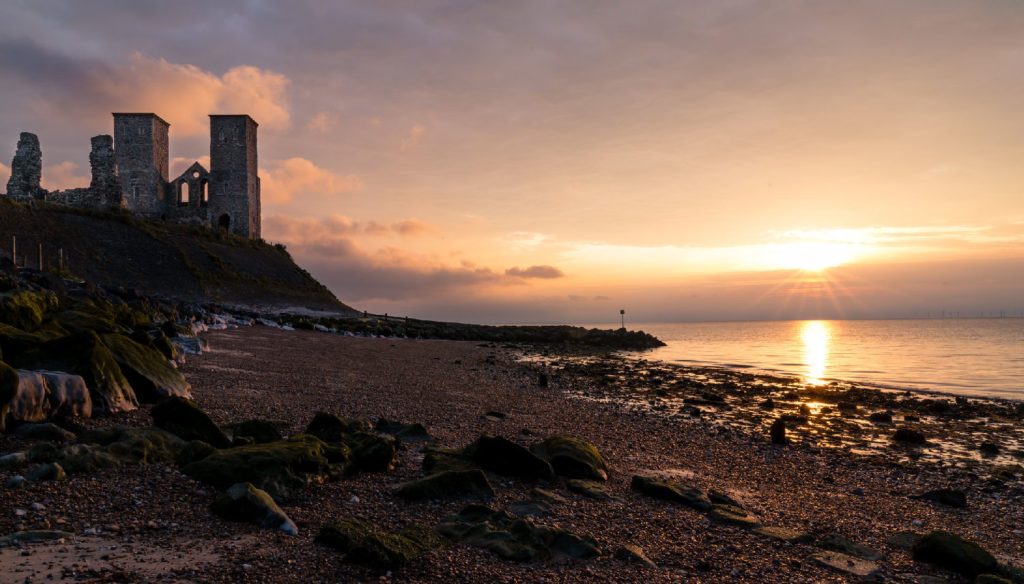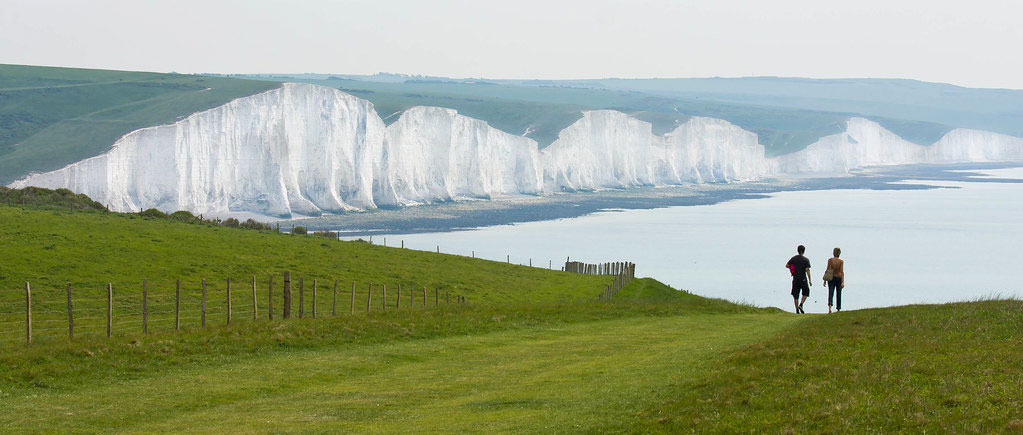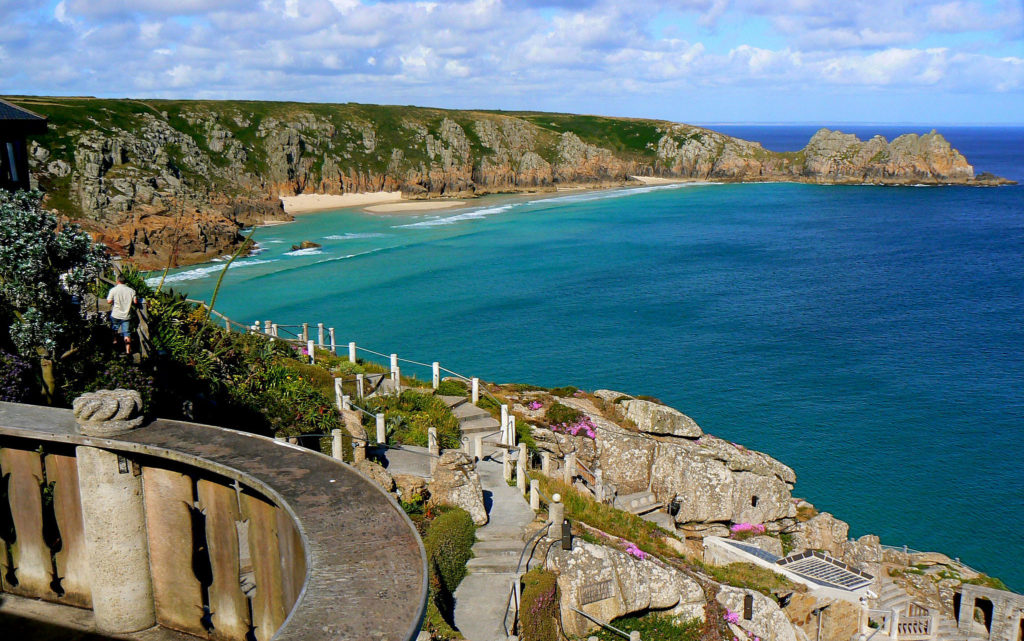May is the national walking month, which is great, as spring is now well underway and there are some gorgeous sights to see across the UK. Rolling hills, coastal views and wildflowers, as well as the weather being warmer and the days getting longer. It’s the perfect month to break out your walking shoes, get moving, and take in some of the sights of your local area – or further afield.
Most of us know that it’s recommended that we should walk 10,000 steps a day, which can seem like quite a challenge sometimes, especially if you work full time and need to commute. However, there are ways to squeeze in a few extra steps during the working day, such as taking a lunchtime walk. This can give you a nice (and often much-needed) break from the computer screen, as well as giving you a good dose of fresh air and Vitamin D (something we need for healthy, strong bones).

Health Benefits to Walking
There are so many health benefits to walking, and even though you might ache a little if you aren’t used to walking, your body will be thanking you in many different ways. Here are just some of the ways in which you can improve your health by taking up regular walking:
- Increased cardiovascular health
- Reduced risk of heart disease
- Reduced risk of stroke
- Management of blood pressure and cholesterol
- Reduction of some joint and muscular pain
- Helps with some symptoms of diabetes
- Stronger bones
- Improved balance
- Increased muscle strength
- Reduced body fat
- Increased intake of vitamin D
We spoke to David Della Cioppa, Personal Trainer at PT Corner in Derbyshire about the benefits of walking as an exercise, who said:
"Walking is a fantastic and free way to help improve your health. You can do it on your own, with family or friends. It helps to improve your respiratory and cardiovascular systems. Aim to reach 10,000 steps per day to attain your physical activity recommendations."

Getting prepared:
Whilst walking is mostly free, it’s good to get yourself properly prepared by making sure you have the right equipment. Most importantly, you’ll need a comfortable and well-fitting pair of shoes. They don’t have to cost the earth, but they should be suitable enough to not let water in, give you support over various types of terrain, and be durable. If you’re planning on walking more often, or for longer distances, it might be a good idea to invest in a good pair of walking shoes or boots as you’ll be spending a lot of time in them and your feet will be carrying the weight of your whole body.
You should also think about a suitable bag to take. Whilst shoulder-strap bags are fashionable, they can actually do more harm than good. Finding a rucksack that’s big enough to carry things like water, spare socks and a jacket is a great idea to make sure you’re prepared and hydrated throughout the walk. We recommend a rucksack or backpack purely because they can be adjusted to sit close to your centre of gravity. This means that less stress is placed on your upper back, and you should feel comfortable and have your hands free during your walk.
It’s also a good idea to set up a device to track your progress. Most smartphones now have a health app that can track how many steps you do, and even how many calories you’ve burnt. Setting this up on your phone is usually easy and some of the apps have a whole range of features that you can play with to spur you on. Alternatively, wearable devices are also available that can track your heart rate as you exercise.
Now that you’re all prepared, we can finally unveil our top 10 short-moderate walks in the UK.

Our top 10 moderate walks in the UK
It’s a small world, but there’s so much in it. It certainly wasn’t easy to choose a top 10 list of walks in the UK, and there are thousands more to choose from if you’re feeling more adventurous or can’t find one close enough to you from this list, but we’ve tried to choose trails that have easy access (for those that might struggle with difficult terrain), and don’t take more than 4 hours. It’s more of a beginner’s guide to walking in the UK, but we hope you can enjoy the beauty in some of these trails. Here they are in no particular order.

1. Kent – South East. Minnis Bay to Reculver
This trail is an easy-access trail, meaning that those who struggle with rocky or steep terrain should be absolutely fine during this walk. It’s approximately 3.5 miles one-way, and leads you up the Thanet coast, giving you a blast of sea-air and plenty of scenery. You’ll be walking beside the chalk cliffs of Kent on this trail, and if you allow enough time, you can take in the tidal pool at minnis bay, as well as stopping at Reculver Visitor Centre for refreshments. Reculver’s medieval towers sit at the coastline of Herne Bay, and are packed with history. It’s a perfect walk for beginners, especially those that are interested in history and ancient ruins, as well as budding photographers.
Time to complete: 1-1.5 hours average.
Click here for the Minnis Bay - Reculver route

Reculver Towers and Roman Fort, Herne Bay, Kent.
Image Credit: G.Weston. Flickr
2. Essex – South East. The John Ray Walk
This is the longest walk on our list, not quite reaching 10 miles. It’s more of a day-out walk than something to squeeze in one evening after work, but the scenery makes it worth it. The walk takes you from Braintree to Witham and is named after British historian John Ray. The trail takes you through the valley of the river brain, and the general advice for this walk is to take a good pair of walking boots or wellies, especially if it’s recently been raining.
Time to complete: 2-4 hours depending on walking speed
Click here for the John Ray Walk route
3. Liverpool – North West. Otterspool Promenade to Pier Head
The worst-kept secret in Liverpool is the picturesque walk from otterspool promenade to Pier Head – the home of the three graces that sit proudly upon the River Mersey. It’s an ideal walk for anyone who likes architecture and history, as well as those looking to visit a museum (there are several around Pier Head) or to hit the shops. Pier Head is just over the road from Liverpool One - Liverpool’s main shopping district. You can do the walk in either direction, but we’d recommend starting at Otterspool so you can spend as much time as you like taking in the beauty of Liverpool. The walk is around 4 miles long depending on which route you take, and is an easy access walk so those who can't handle rough terrain are able to enjoy the views as well.
Time to complete: 1-1.5 hours on average.

Pier Head in Liverpool, showing the 3 graces.
Image credit: Peter Tarleton
Click here for the Otterspool Promenade-Pier Head route
4. Derbyshire – East Midlands. Ladybower Reservoir and the Derwent Dams
Another historical site in our list is the place where the Dambusters practiced ahead of the war. Occasionally, a flypast takes place here, so it might be worth checking with the RAF or the visitor centre at the reservoir if there’s one happening soon. It really is a sight for sore eyes and if you can, we’d recommend tying the walk in with a fly-past.
On this trail, you get to see the Derwent Dams, and depending on which route you take and how low the water levels are, you might even be able to see the ruins of Derwent Village, which was flooded to build the reservoir (however, we don’t recommend going right down to the ruins as the ground can be incredibly dangerous). It’s around 4 miles long and more suited to those who can handle some rough terrain, as not all of it is easy-going. The site is cared for by the National Trust, so whilst there might be some rules or restrictions, it's worth it to preserve the beauty and history of the Derwent.
Time to complete: around 2 hours depending on walking speed
Click here for the Ladybower and Derwent Dam route
5. Lancashire – North West. Tolkien Trail
This walk takes you through the Ribble Valley, with views of Stoneyhurst College where the author spent some time during World War II writing the famous Lord of the Rings Trilogy. It’s a beautiful, picturesque 5.5 mile walk with plenty of places for you to take in the River Ribble. It’s as close to middle earth as you can get, with the surroundings no doubt inspiring Tolkien for the books.
Time to complete: 2 hours approximately
Click here for the Tolkien Trail route
6. Sussex – South East. Seven Sisters – Birling Gap
For this trail, you’ll be walking atop the cliffs of the famous seven sisters - a group of chalky cliffs that’s one of the most famous beauty spots in Sussex. This circular walk is around 8 miles long, and also lets you take in Friston Forest. It's more of a day-trip walk than most, but worth it for the stunning views and sea air. The seven sisters sit between Seaford and Eastbourne, so there’s plenty to do around the area once you’ve finished your walk. Also perfect for budding photographers, especially around sunrise and sunset (though make sure you’re not walking along the clifftops in the dark).
Time to complete: 6 hours average.
Click here for the Seven Sisters route

The Seven Sisters, Sussex.
Image credit: Edward Dalmulder, Flickr
7. Cornwall –South West. Porthcurno to Land’s End.
There’s absolutely no doubting Cornwall’s beauty. A favourite UK “staycation” spot, it’s perfect for locals and visitors alike. This walk is also around 6.6 miles and is another of Britain’s best coastal walks. With rocky scenery and plenty of hidden bays on the way, it’s certainly a walk to make a day of, especially to see the famous Minack Theatre.
Time to complete: around 3 hours.
Click here for the Porthcurno-Land's End route

Views of one of the Cornish bays from the Minack Theatre.
Image credit: Ozzy Delaney, Flickr
8. Snowdonia – Wales. Cwm Idwal
Around 3 miles long, this walk promises breath-taking views of the mountains of Snowdonia. It’s described as a moderately strenuous walk, so it’s probably not for beginners. Cwm Idwal is a National Trust walk, so you know you’re guaranteed to be in a place of natural beauty. Whilst it’s a walk for those with a little more experience, we definitely recommend that you walk this trail once you’ve built up enough stamina.
Time to complete: around 3 hours.
Click here for the Cwm Idwal route
9. Ayrshire – Scotland. Peden’s Cove
This walk takes place in Ayrshire’s Ayr Gorge Woodland, and you’ll reach the cove around a mile into the trail. Peden’s Cove is set in a red sandstone canyon, meaning that when the sun shines, the water in the gorge glistens a copper colour. The Peden’s Cove walk is dog-friendly, so if you’re in the area with your pooch, it’s safe to take them along. Once you reach the cove and take in the beauty, you simply walk back along the same route, making it a 2 mile walk.
Time to complete: 1 hour average.
Click here for the Peden's Cove route
10. Antrim, Northern Ireland. Giant’s Causeway.
This is probably one of Northern Ireland’s most famous landmarks, and it’s on this list for a reason. There are several trails you can take along the Giant’s Causeway, all signposted by colour. This is another route that’s looked after by the National Trust, and it’s easy to see why it’s a protected area. The ancient rock formation is the result of a volcanic fissure eruption that took place over 50 million years ago. Most trails are around 2 miles long and take around an hour to complete at a leisurely pace, but you can always do more than one trail whilst you’re there to make the most of your time.
Time to complete: roughly an hour depending on which route you take.
Click here for the routes around the Giant's Causeway

The Giant's Causeway at sunset.
Image credit: Giuseppe Milo, Flickr
Want to start walking more?
If you think you'd like to start walking regularly, there are several things you can do. You can start by walking around your local area, or branching out further afield and take a walking holiday. There are even associations for people that love walking in the British countryside. For example, a Ramblers membership is only £35.85 for an entire year, and it goes towards making sure that many beautiful trails are kept open for the public, as well as promoting the benefits of walking to a wider audience.
Walking in a group can make it even more fun, as it's a great, cheap (often even free) way of spending quality time with friends or relatives.
The most important things to remember are:
- Go at your own pace. Don't push yourself too hard
- Don't trespass. Stick to public footpaths
- Go prepared. The right footwear and clothing can make all the difference
- Stay hydrated. Even if you aren't walking at a brisk pace, you still need to drink plenty of fluids
- Enjoy yourself. Walking is something you should enjoy and not see as a chore.










